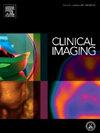Impact of artificial intelligence assisted lesion detection on radiologists' interpretation at multiparametric prostate MRI
IF 1.8
4区 医学
Q3 RADIOLOGY, NUCLEAR MEDICINE & MEDICAL IMAGING
引用次数: 0
Abstract
Purpose
To compare prostate cancer lesion detection using conventional and artificial intelligence (AI)-assisted image interpretation at multiparametric MRI (mpMRI).
Materials and methods
A retrospective study of 53 consecutive patients who underwent prostate mpMRI and subsequent prostate tissue sampling was performed. Two board-certified radiologists (with 4 and 12 years of experience) blinded to the clinical information interpreted anonymized exams using the PI-RADS v2.1 framework without and with an AI-assistance tool. The AI software tool provided radiologists with gland segmentation and automated lesion detection assigning a probability score for the likelihood of the presence of clinically significant prostate cancer (csPCa). The reference standard for all cases was the prostate pathology from systematic and targeted biopsies. Statistical analyses assessed interrater agreement and compared diagnostic performances with and without AI assistance.
Results
Within the entire cohort, 42 patients (79 %) harbored Gleason-positive disease, with 25 patients (47 %) having csPCa. Radiologists' diagnostic performance for csPCa was significantly improved over conventional interpretation with AI assistance (reader A: AUC 0.82 vs. 0.72, p = 0.03; reader B: AUC 0.78 vs. 0.69, p = 0.03). Without AI assistance, 81 % (n = 36; 95 % CI: 0.89–0.91) of the lesions were scored similarly by radiologists for lesion-level characteristics, and with AI assistance, 59 % (26, 0.82–0.89) of the lesions were scored similarly. For reader A, there was a significant difference in PI-RADS scores (p = 0.02) between AI-assisted and non-assisted assessments. Signficant differences were not detected for reader B.
Conclusion
AI-assisted prostate mMRI interpretation improved radiologist diagnostic performance over conventional interpretation independent of reader experience.
人工智能辅助病变检测对放射科医师多参数前列腺MRI解释的影响
目的比较传统多参数MRI (mpMRI)与人工智能(AI)辅助图像解释对前列腺癌病变的检测效果。材料与方法对53例连续行前列腺mpMRI检查并进行前列腺组织取样的患者进行回顾性研究。两名委员会认证的放射科医生(分别有4年和12年的经验)对临床信息不知情,使用PI-RADS v2.1框架,在没有人工智能辅助工具的情况下解释了匿名检查。人工智能软件工具为放射科医生提供腺体分割和自动病变检测,为临床显著前列腺癌(csPCa)存在的可能性分配概率分数。所有病例的参考标准均为系统和定向活检的前列腺病理。统计分析评估了医生之间的一致性,并比较了在有人工智能辅助和没有人工智能辅助的情况下的诊断表现。结果在整个队列中,42名患者(79%)患有格里森阳性疾病,25名患者(47%)患有csPCa。放射科医生对csPCa的诊断表现明显优于人工智能辅助下的传统解释(阅读器A: AUC 0.82 vs. 0.72, p = 0.03;读者B: AUC 0.78 vs. 0.69, p = 0.03)。没有人工智能辅助,81% (n = 36;95% CI: 0.89-0.91),放射科医生对病变水平特征进行了相似的评分,在人工智能的帮助下,59%(26,0.82 - 0.89)的病变进行了相似的评分。对于读者A, ai辅助和非辅助评估在PI-RADS得分上存在显著差异(p = 0.02)。结论人工智能辅助前列腺mMRI解读比传统解读提高了放射科医生的诊断性能,而不依赖于解读者的体验。
本文章由计算机程序翻译,如有差异,请以英文原文为准。
求助全文
约1分钟内获得全文
求助全文
来源期刊

Clinical Imaging
医学-核医学
CiteScore
4.60
自引率
0.00%
发文量
265
审稿时长
35 days
期刊介绍:
The mission of Clinical Imaging is to publish, in a timely manner, the very best radiology research from the United States and around the world with special attention to the impact of medical imaging on patient care. The journal''s publications cover all imaging modalities, radiology issues related to patients, policy and practice improvements, and clinically-oriented imaging physics and informatics. The journal is a valuable resource for practicing radiologists, radiologists-in-training and other clinicians with an interest in imaging. Papers are carefully peer-reviewed and selected by our experienced subject editors who are leading experts spanning the range of imaging sub-specialties, which include:
-Body Imaging-
Breast Imaging-
Cardiothoracic Imaging-
Imaging Physics and Informatics-
Molecular Imaging and Nuclear Medicine-
Musculoskeletal and Emergency Imaging-
Neuroradiology-
Practice, Policy & Education-
Pediatric Imaging-
Vascular and Interventional Radiology
 求助内容:
求助内容: 应助结果提醒方式:
应助结果提醒方式:


